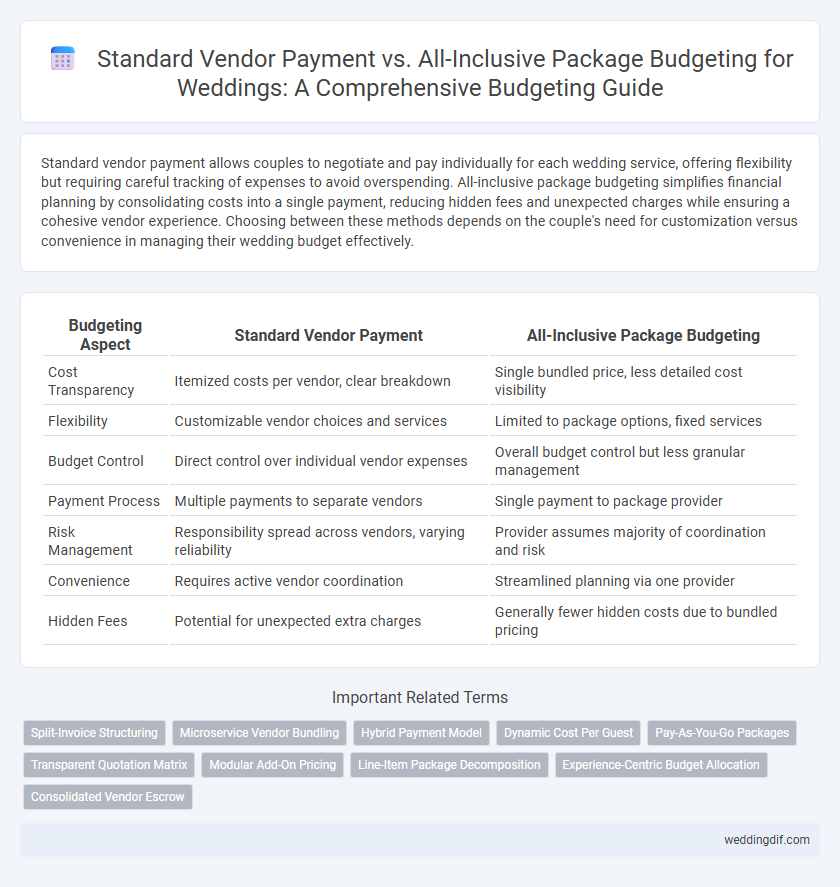Standard vendor payment allows couples to negotiate and pay individually for each wedding service, offering flexibility but requiring careful tracking of expenses to avoid overspending. All-inclusive package budgeting simplifies financial planning by consolidating costs into a single payment, reducing hidden fees and unexpected charges while ensuring a cohesive vendor experience. Choosing between these methods depends on the couple's need for customization versus convenience in managing their wedding budget effectively.
Table of Comparison
| Budgeting Aspect | Standard Vendor Payment | All-Inclusive Package Budgeting |
|---|---|---|
| Cost Transparency | Itemized costs per vendor, clear breakdown | Single bundled price, less detailed cost visibility |
| Flexibility | Customizable vendor choices and services | Limited to package options, fixed services |
| Budget Control | Direct control over individual vendor expenses | Overall budget control but less granular management |
| Payment Process | Multiple payments to separate vendors | Single payment to package provider |
| Risk Management | Responsibility spread across vendors, varying reliability | Provider assumes majority of coordination and risk |
| Convenience | Requires active vendor coordination | Streamlined planning via one provider |
| Hidden Fees | Potential for unexpected extra charges | Generally fewer hidden costs due to bundled pricing |
Introduction to Wedding Budgeting Approaches
Standard vendor payment budgeting allocates specific amounts to individual services like catering, photography, and venue rental, offering clear cost visibility and control over each vendor. All-inclusive package budgeting consolidates multiple wedding services into a single price, simplifying the planning process and often providing cost savings through bundled deals. Understanding these approaches helps couples make informed decisions aligned with their financial goals and event preferences.
What Is Standard Vendor Payment?
Standard vendor payment involves allocating specific amounts to individual wedding service providers such as photographers, caterers, and florists, based on agreed contracts or quotes. This method provides clear visibility into each vendor's cost, enabling precise tracking and adjustments throughout the budgeting process. It contrasts with all-inclusive package budgeting, where a single price covers multiple services, often limiting customization and detailed expense management.
What Is an All-Inclusive Wedding Package?
An all-inclusive wedding package consolidates multiple services such as venue, catering, decor, and entertainment into a single, upfront price, simplifying budget management and reducing unexpected costs. Standard vendor payments require separate contracts and individual payments for each service provider, often leading to variable expenses and more complex tracking. Opting for an all-inclusive package streamlines financial planning and ensures a cohesive event experience through coordinated vendor services.
Pros and Cons of Standard Vendor Payment
Standard vendor payment offers precise control over individual expenses, allowing couples to allocate funds specifically to preferred services such as catering, photography, or entertainment. This method enables customized vendor selection and potential cost savings through targeted negotiations but can result in hidden fees and unexpected charges due to fragmented contracts. However, managing multiple vendors independently increases the complexity and time investment required for coordination and may lead to logistical challenges on the wedding day.
Advantages and Disadvantages of All-Inclusive Packages
All-inclusive package budgeting for weddings offers streamlined planning and predictable costs by bundling services such as venue, catering, and decor into a single price, reducing the risk of unexpected expenses. However, it may limit customization options and flexibility, potentially leading to compromises in vendor selection or specific preferences. Couples opting for all-inclusive packages should weigh the convenience and cost certainty against the possibility of higher overall prices and less personalized experiences.
Cost Comparison: Standard Vendor vs All-Inclusive Package
Standard vendor payments often break down costs by individual services, potentially leading to higher total expenses due to separate vendor fees, taxes, and gratuities. All-inclusive package budgeting consolidates venue, catering, decor, and entertainment into one fixed price, offering streamlined cost management and often better overall value. Couples seeking to control wedding expenses should analyze detailed vendor quotes against comprehensive package deals to identify hidden fees and optimize budget allocation.
Flexibility and Customization: Which Approach Wins?
Standard Vendor Payment offers limited flexibility as clients pay fixed rates for individual services, restricting customization options for unique wedding needs. All-Inclusive Package Budgeting enhances customization by bundling multiple services into one adaptable package, allowing couples to tailor elements without constant vendor negotiations. For couples prioritizing flexibility and personalized experiences, all-inclusive packages provide a more versatile and client-centric budgeting approach.
Hidden Fees and Unexpected Costs to Watch Out For
Standard vendor payment often conceals hidden fees such as service charges, overtime costs, and equipment rentals, which can significantly inflate the wedding budget beyond initial estimates. All-inclusive package budgeting typically provides upfront transparency by bundling venue, catering, and entertainment costs, reducing the risk of unexpected expenses. Couples should meticulously review contract details and inquire about potential surcharges to avoid financial surprises on their wedding day.
Tips for Choosing the Right Budgeting Method
When selecting between Standard Vendor Payment and All-Inclusive Package Budgeting for weddings, prioritize clarity on vendor services and hidden costs to ensure accurate cost prediction and control. Evaluate the flexibility of each method in accommodating changes and personal preferences, as Standard Vendor Payment allows customization while All-Inclusive Package may streamline expenses and reduce management complexity. Assess your comfort with vendor negotiation and your capacity to track multiple payments to choose a budgeting approach that aligns with your organizational skills and financial goals.
Final Thoughts: Making the Best Choice for Your Wedding Budget
Choosing between standard vendor payments and an all-inclusive package budget depends on your priorities for transparency and flexibility versus convenience and simplicity. Standard vendor payments allow detailed control over individual services, enabling personalized customization and potential cost savings by negotiating each element separately. All-inclusive packages offer streamlined budgeting with fixed prices, reducing planning stress but may include unnecessary features or limit vendor choice, so evaluating your wedding priorities ensures the most efficient allocation of funds.
Standard Vendor Payment vs All-Inclusive Package Budgeting for weddings. Infographic

 weddingdif.com
weddingdif.com